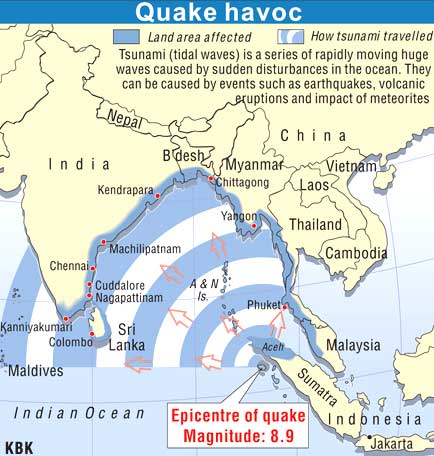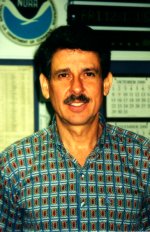| Home Here is the link to the actual warnings from the Hawaii center Pacific Tsunami As for the foreign bodies like Pacific..NOAA and
newsmedia like BBC and CNN, they are spreading wrong
information too, stressing too much on the Membership
in the Warning setup. It appears that they are more
interested in the MEMBERSHIP and the money it generates,
rather than avoiding a disaster. |
Tsunami Disaster and 'Warning Claims'!
McCreery of the Pacific
Tsunami Warning Centre appeared
on TV and news media claiming that "The absence of an
alert system in Asia meant the information could not be
sent out fast enough to save any of the more than 23,000
lives that were lost in the catastrophe. Charles McCreery "We did what we could to
warn Asian nations of the likelihood of a tsunami,"
said Charles McCreery of the Pacific Tsunami Warning
Centre in Honolulu, adding that the centre did not have
direct contacts with Indian ocean nations. " The
centre issued a bulletin at 0114 GMT when it detected the
temblor off the coast of Indonesia, but with no early
warning system in place in Asia, scientists had no choice
but to begin working their phones. We will see that this is not true at all. In fact, the NOAA site itself never highlighted the danger. They never informed the proper agencies. None of the main news bureaus like Reuters, AP or AFP were alerted. We do not say that Mr McCreery did naything wrong; but with all his knowledge, he too misjudged the earthquake was just inefficient as anyone else in the disaster region whose knowledge on tsunami was much limited. The following letter was sent to [email protected] at the NOAA Center in Hawai Hello Mr McCreery, In the wake of the Asian disaster, news
media is full of talk about lack of any warning system in
Asia and its disastrous consequences ... It is true that
there is no tsunami warning system as such in the region.
But the Earthquake is monitored and based on the
magnitude 8.5 (later 9.0), scientists should have still
predicted huge tidal waves and warned people. For
countries like India and Sri Lanka, they had about 3
hours time to take action. |
||||||||||||||||||||||||||||||||||||||||||||||||||||||
Many of the claims here are bogus. Reality of the matter is that they in Honolulu grossly underestimated the impact and strength of the tsunamis. This way, with all the equipments and experience on tsunamis, they did nothing better than the earthquake monitoring centers in the Indian Ocean Rim. |
All eyes on Pacific
tsunamis from Hawaii Tuesday December 28, 2004 07:13 - (SA) http://www.suntimes.co.za/zones/sundaytimesNEW/basket7st/basket7st1104210827.aspx LOS ANGELES - An alert centre in Hawaii that warns Pacific countries about approaching tsunamis had detected the earthquake that generated killer waves across Asia, but had no way of raising the alarm. The absence of an alert system in Asia meant the information could not be sent out fast enough to save any of the more than 23,000 lives that were lost in the catastrophe. "We did what we could to warn Asian nations of the likelihood of a tsunami," said Charles McCreery of the Pacific Tsunami Warning Centre in Honolulu, adding that the centre did not have direct contacts with Indian ocean nations. The centre, set up by the National Oceanic and Atmospheric Administration (NOAA) in 1949 after a huge wave killed 159 people in Hawaii, tried desperately to warn Asian nations through US embassies in their capitals. "From our instruments we can detect any large earthquake in the Pacific, usually within two to three minutes of the occurrence of the earthquake, and warn any country that is threatened," he said. The centre issued a bulletin at 0114 GMT when it detected the temblor off the coast of Indonesia, but with no early warning system in place in Asia, scientists had no choice but to begin working their phones. "We knew that the whole coast of Sumatra was capable of large, damaging earthquakes and large tsunamis," said US Geological Survey geophysicist Ken Hudnut. "There was sufficient time between the time of the quake and the time of the tsunamis hitting some of the affected areas to have saved many lives, if a proper warning system had been in place," he said. The NOAA's information bulletin said there was a possibility of a tsunami near the earthquake's epicentre, but that no destructive threat existed in the Pacific. But huge tidal waves swept across the Indian Ocean killing at least 23,000 people in nine countries from Indonesia to Somalia. The tsunami is believed to be the first in the Indian Ocean since 1883, possibly explaining why coastal inhabitants of the region were so unprepared for the disaster. "Because they are such a rare occurrence, perhaps the tradition of warning about the hazards of tsunamis is no longer handed down from generation to generation," Hudnut said. Records dating back to 1509 show that Indian Ocean tsunamis have never hit more than one place at one time, Eddie Bernard , director of the Pacific Marine Environmental Laboratory in Seattle, Washington, told The Wall Street Journal. "There do not seem to be any tsunamis that were Indian Ocean-wide," Bernard said. There are almost no tsunami alert systems for the Indian Ocean to give populations sufficient time to flee the deadly waves, the NOAA said. The International Tsunami Information Centre was created in 1965 as part of Unesco, the UN science and education agency, to better prepare Pacific countries against the giant waves. The United States has a second tsunami warning centre in Alaska that was established in 1967, following a 1964 earthquake that unleashed a tsunami responsible for 122 deaths. The US tsunami centres get information from the National Data Buoy Centre, whose network of buoys measure the size of waves. US earthquake experts say that in an age of booming international travel and tourism, people all over the world should be aware of what to do in the case of a major earthquake that could spawn a tsunami. "People who spend any time at all - even vacations - in coastal communities should know that when there is a major quake they should make their way to high ground as quickly as possible because a tsunami could soon follow," Hudnut said. "Being prepared for such calamities is part of being a savvy traveller," he said. AFP |
||||||||||||||||||||||||||||||||||||||||||||||||||||||
| The Tsunamis
the Pacific Center has been monitoring! The http://www.prh.noaa.gov/ptwc/abouttsunamis.htm gives Examples of some recent tsunamis are shown in the table below:
|
|||||||||||||||||||||||||||||||||||||||||||||||||||||||
| That much common sense, competence and timely action
was missing from all the Earthquake Warning Centres
around the world - India, Asia, Europe, the USA and
Hawai! Instead they cry about tsunami warning system. Earthquake magnitude should have been enough to predict a tsunami catastrophe. |
10 year old
Tilly saved her family and another 100 tourists! The Sun, London reports http://www.thesun.co.uk/article/0,,2-2004610510,00.html A BRITISH girl aged ten saved 100 tourists from the tsunami — thanks to a geography lesson. Tilly Smith, who studied the huge waves in school two weeks before Christmas, realised a Thai beach was about to be swamped when the tide shot out. She and mum Penny, of Oxshott, Surrey, raised the alarm and the sands were evacuated. |
||||||||||||||||||||||||||||||||||||||||||||||||||||||
| Here comes tbe bluff. If someone says, he had not
heard of tsunami we can accept that. But those who
claim that they have been warning the Govt of a tsunami
before, they are the biggest cheats. Because they knew
about tsunami and still failed to act, failed to see that
an 8.5 (9 later) earthquake would create tsunami. Why
didn't they take up the phone and warn someone - media or
the Govt...? In another news TOI
writes at http://timesofindia../977960.cms |
Why weren't we
warned, aggrieved India asks - The
Times of India SATURDAY, JANUARY 01, 2005
03:37:37 PM ] NEW DELHI: For two and a half hours the tsunami sped towards the Indian coast, yet nobody was warned. The waves struck Indonesia, Thailand and then
submerged an air force base at Car Nicobar, 1,200 km from
the mainland. |

